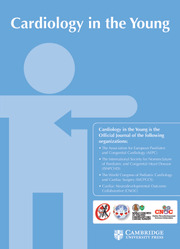No CrossRef data available.
Article contents
Percutaneous VenusP-valve implantation in the paediatric population
Published online by Cambridge University Press: 13 May 2025
Abstract
To assess short- and medium-term outcomes of VenusP-valve implantation in the pulmonary position in the paediatric population.
Percutaneous pulmonary valve implantation is now an established alternative to surgical pulmonary valve replacement, especially in those with conduits in the right ventricular outflow tract. The VenusP-valve™ (Venus Medtech, Shanghai, China) has demonstrated early efficacy in the adult population with larger conduit-free right ventricular outflow tracts. However, its use in children has not been well described.
Retrospective review of patients under 18 years of age undergoing VenusP-valve implantation at a single institution between June 2015 and February 2023.
Fifteen patients under the age of 18 years underwent VenusP-valve™ implantation. All had severe pulmonary regurgitation and fulfilled accepted criteria for pulmonary valve implantation. Mean age at valve implantation was 14.1 (range 9.8–17.9) years, and mean weight was 54.9 (34.0–98.5) kg. The valve was deployed successfully in all the patients. The valve diameter and length ranged between 28–36 mm and 25–35 mm, respectively. Mean follow-up was 3.4 (0.5–8.1) years. At follow-up, twelve patients have undergone magnetic resonance imaging MRI as part of the regular surveillance. Indexed right ventricular end-diastolic volume improved from 157.8 (140.0–197.0) ml/m2 to 117.6 (91.0–152.0) ml/m2 (p = 0.004). Pulmonary regurgitation fraction had reduced from a mean of 44.3 (31.0–60.0) % to 3.6 (0.0–15.0) % (p = 0.003).
This study demonstrates the safety and feasibility of the VenusP-valve implantation in children. Medium-term follow-up suggests that valve implantation is associated with a reduction in the degree of pulmonary regurgitation and right ventricular end-diastolic volume.
Keywords
Information
- Type
- Original Article
- Information
- Copyright
- © The Author(s), 2025. Published by Cambridge University Press


